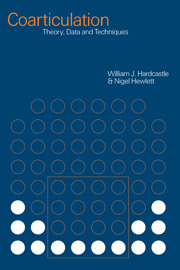Book contents
- Frontmatter
- Contents
- List of figures
- List of tables
- List of contributors
- Acknowledgments
- Introduction
- Part I Theories and models
- Part II Research results: components of the motor system for speech
- 3 Velopharyngeal coarticulation
- 4 Lingual coarticulation
- 5 Laryngeal coarticulation
- 6 Labial coarticulation
- 7 Lip and jaw coarticulation
- Part III Wider perspectives
- Part IV Instrumental techniques
- References
- Index
7 - Lip and jaw coarticulation
Published online by Cambridge University Press: 22 September 2009
- Frontmatter
- Contents
- List of figures
- List of tables
- List of contributors
- Acknowledgments
- Introduction
- Part I Theories and models
- Part II Research results: components of the motor system for speech
- 3 Velopharyngeal coarticulation
- 4 Lingual coarticulation
- 5 Laryngeal coarticulation
- 6 Labial coarticulation
- 7 Lip and jaw coarticulation
- Part III Wider perspectives
- Part IV Instrumental techniques
- References
- Index
Summary
Introduction
Lip and jaw or mandibular movements in speech production have been extensively studied (see e.g. Lindblom 1967; Perkell 1969; Lindblom and Sundberg 1971; Kelso et al. 1985; Ostry and Munhall 1994; Vatikiotis-Bateson and Ostry 1995; Ostry, Gribble and Gracco 1996), partly because they are more amenable to direct instrumental investigation than other speech articulators which often require invasive techniques. The types of investigations are numerous and include movement and kinematic studies (using e.g. cinefluorography, the X-ray microbeam system, strain-gauge and optoelectronic devices and electromagnetic midsagittal articulatory tracking devices), studies of the mandibular and labial muscle systems (using electromyography) and numerous acoustic analyses.
Briefly, the jaw is a large and relatively sluggish articulator compared to the tongue tip or blade, for example. Extensive studies of jaw motion by Ostry and Munhall (1994) and Vatikiotis-Bateson and Ostry (1995) among others, suggest that during jaw opening in a CV sequence the jaw rotates downwards and moves forward, whereas during closure (i.e. VC) the jaw rotates upwards and translates backwards. The jaw also provides a framework for both lingual and labial gestures (e.g. Perkell 1969). For example bilabial closure is achieved via contribution of the jaw and upper and lower lips. The jaw is connected to both the hyoid bone and tongue. Consequently, movement of the jaw alters the position of the tongue and to a lesser extent overall tongue shape (e.g. Linblom and Sundberg 1971).
- Type
- Chapter
- Information
- CoarticulationTheory, Data and Techniques, pp. 164 - 176Publisher: Cambridge University PressPrint publication year: 1999
- 3
- Cited by



